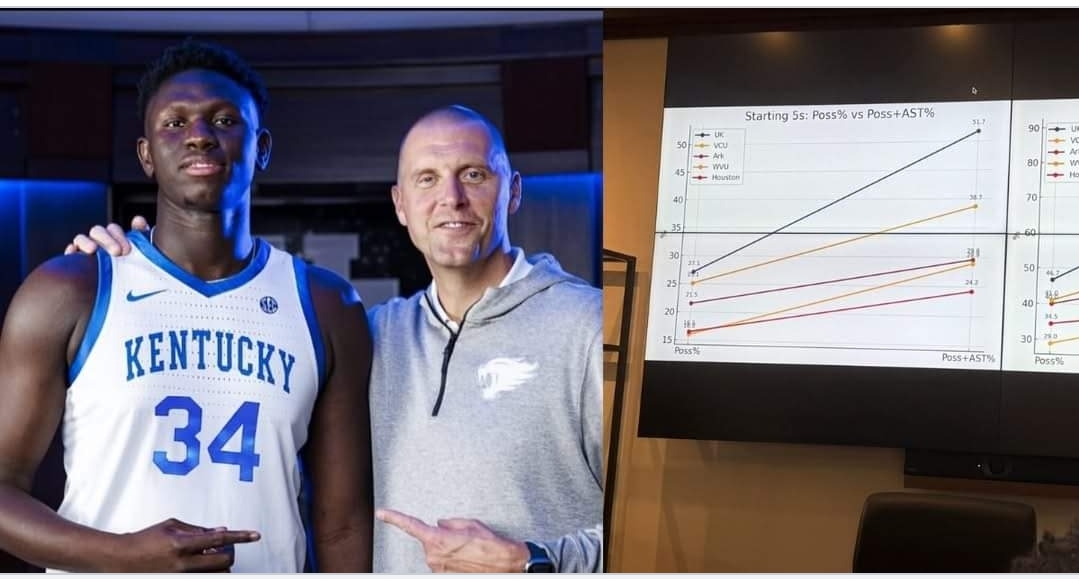### Mark Pope’s “Big Men First” Blueprint
Since taking over at Kentucky, Mark Pope has made it clear he intends to build an offense that leans heavily on big men—not just around the rim, but as playmakers and decision‑makers. One of the most compelling proofs of concept has been **Amari Williams**, a transfer from Drexel, whose role last season illustrated Pope’s philosophy about how a “big” can contribute.
At Drexel, Williams averaged about **12.2 points, 7.8 rebounds, 1.9 assists, and 1.8 blocks per game** while logging around **22.9 minutes per game**. ([kentucky.com][1]) What’s particularly instructive is his *usage rate*, which for a big man at Drexel was high: he ranked among the national leaders in percentage of possessions used. ([kentucky.com][2])
Pope has said explicitly that Williams “fits into exactly what we want to do on either end of the court.” ([KY Insider][3]) In simple terms: Kentucky under Pope wants bigs who can defend, rebound, block shots, pass well, initiate or facilitate offense, and move smartly—not just be finisher near the rim. ([kentucky.com][4])
—
### The Pitch to Arafan Diane & Other Finalists
As Kentucky courts **Arafan Diane**, those patterns are central to the pitch. Diane’s guardian, Alex Victor, recently told *Kentucky Wildcats on SI* that “one of Pope’s biggest selling points was the way he used Amari Williams last season and how he played through him on offense a lot.” ([SI][5])
Diane is a 7’1”, 260‑lb four‑star center who’s been drawing interest from many top programs. Contrary to some schools, Kentucky is presenting a vision where Diane wouldn’t just be a lob target, but someone who can touch the ball, make reads, operate from the post or around the basket, and be integral to the flow of offense. ([SI][5]) The usage of Williams becomes the empirical backbone of that vision: Kentucky is able to say, “Here’s someone we already did that with, and look at how it transformed his game and impact.”
—
### What the Graphs Likely Show & Implications
Although the exact graphs referenced in KSR+ haven’t been published in full public detail, their content can be inferred from what Pope and his staff have emphasized, and what the media have reported:
* **Comparative usage rates**: How often bigs like Williams (and before him, Aly Khalifa at BYU) touch the ball, end possessions (by shot, assist, or otherwise), compared with big men recruited by other finalists like Diane. Pope will want to show that Kentucky offers more offensive involvement.
* **Assist‐to‐turnover ratios for bigs**: Probably shown to argue that Kentucky’s system doesn’t merely *give* bigs more responsibility—it also helps them execute cleanly.
* **Efficiency windows**: Pope has spoken of analyzing when players are most efficient—minutes, game situations, etc. Williams’ production tends to peak in certain minute ranges (\~20‑28 minutes) based on reports. ([KY Insider][6]) Graphs likely display this, showing that Kentucky doesn’t necessarily demand maximum minutes for bigs at the expense of effectiveness.
* **Defensive impact**: Blocks, rebounding, rim protection – probably shown side by side, demonstrating a well‑rounded profile.
For a recruit like Diane, these data visuals help solve several unknowns: Will he be more than a stat padding big? Will Kentucky let him showcase his full skillset? Can he be developed into a 5 who plays in modern ways (passing, spacing, etc.)?
—
### What to Watch
* **Fit vs. role**: Even if Kentucky offers a major role, the competition (other finalists) may promise different things: more scoring, more national spotlight, different offensive styles. How much Diane values the “big who gets used” over “big who scores numbers” may matter.
* **Development & conditioning**: One common theme in many recruitments is the physical demands. Diane’s guardian has noted that “strength and conditioning” are among the pillars in choosing a program. Kentucky will likely lean on the Williams model not just in concept, but in the support structures around him. ([SI][5])
* **Minutes & consistency**: From what we know, Pope is careful about keeping Williams in his most effective minutes windows to avoid efficiency drops. If Diane sees that consistency—versus being benched, or shuffled too much—it may be a key deciding factor.
—
### Conclusion
In summary, Mark Pope has used real evidence—via Williams and his own prior work at BYU—to make a convincing case to big prospects like Diane. The graphs that KSR+ references are likely visualizations of usage, efficiency, assist‑to‑turnover, defensive metrics, and showing how Pope doesn’t see his bigs as simple finishers, but as central actors. For Diane, Kentucky is selling not just an opportunity, but a tested system. Whether that is enough to beat out other finalists depends as much on what Diane wants out of his college experience (role, development, exposure, etc.) as it does on which program can deliver.
If you want, I can pull up the actual graphs from KSR+ and break them down—figure by figure—for more clarity.
